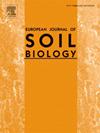Investigating soil trophic links in a peatland, northeast China: Dual stable isotope analysis (δ13C and δ15N) of microarthropods and their food sources
IF 3.3
2区 农林科学
Q1 ECOLOGY
引用次数: 0
Abstract
Peatlands are crucial global carbon sinks and key players in carbon cycles, with their soil food webs supporting vital ecosystem processes. However, trophic relationships and carbon source uses of soil microarthropods in peatlands are poorly understood, limiting our understanding of their role in material cycling and ecosystem stability. Here, we employed dual stable isotope analysis (δ13C and δ15N) to investigate the trophic structure and carbon source utilization of soil microarthropods (Collembola, Oribatida, and Mesostigmata) in the Hani Peatland of northeastern China. Our results reveal clear trophic differentiation among taxa, with Mesostigmata occupying higher positions and Oribatida displaying broader isotopic niches. Although Collembola exhibited a weak correlation between body mass and isotope values, this pattern was not consistent across taxa. Mosses, particularly Polytrichum strictum, contributed significantly to the carbon intake of Collembola and Oribatida. However, δ13C enrichment patterns suggest that carbon transfer is primarily mediated through moss-associated microbial pathways rather than direct moss consumption. These findings provide novel insights into the structure and functioning of peatland soil food webs and highlight the ecological importance of microarthropods in belowground biogeochemical cycling. Understanding their roles is critical for predicting peatland responses to environmental change and informing conservation strategies.
东北泥炭地土壤营养联系研究:微节肢动物及其食物来源的δ13C和δ15N双稳定同位素分析
泥炭地是至关重要的全球碳汇和碳循环的关键参与者,其土壤食物网支持重要的生态系统过程。然而,泥炭地土壤微节肢动物的营养关系和碳源利用尚不清楚,限制了我们对其在物质循环和生态系统稳定中的作用的理解。本文采用双稳定同位素(δ13C和δ15N)分析了哈尼泥炭地土壤微节肢动物(弹虫、甲虫和中刺虫)的营养结构和碳源利用。我们的研究结果揭示了类群间明显的营养分化,中柱头甲占据较高的位置,甲骨甲显示出更广泛的同位素生态位。虽然弹虫的体质量与同位素值的相关性较弱,但这种模式在不同的分类群中并不一致。苔藓类植物对弹虫和甲虫的碳吸收有显著的促进作用,其中以窄曲多毛虫最为显著。然而,δ13C富集模式表明碳转移主要是通过苔藓相关的微生物途径介导的,而不是直接消耗苔藓。这些发现为泥炭地土壤食物网的结构和功能提供了新的见解,并强调了微节肢动物在地下生物地球化学循环中的生态重要性。了解它们的作用对于预测泥炭地对环境变化的反应和为保护策略提供信息至关重要。
本文章由计算机程序翻译,如有差异,请以英文原文为准。
求助全文
约1分钟内获得全文
求助全文
来源期刊

European Journal of Soil Biology
环境科学-生态学
CiteScore
6.90
自引率
0.00%
发文量
51
审稿时长
27 days
期刊介绍:
The European Journal of Soil Biology covers all aspects of soil biology which deal with microbial and faunal ecology and activity in soils, as well as natural ecosystems or biomes connected to ecological interests: biodiversity, biological conservation, adaptation, impact of global changes on soil biodiversity and ecosystem functioning and effects and fate of pollutants as influenced by soil organisms. Different levels in ecosystem structure are taken into account: individuals, populations, communities and ecosystems themselves. At each level, different disciplinary approaches are welcomed: molecular biology, genetics, ecophysiology, ecology, biogeography and landscape ecology.
 求助内容:
求助内容: 应助结果提醒方式:
应助结果提醒方式:


